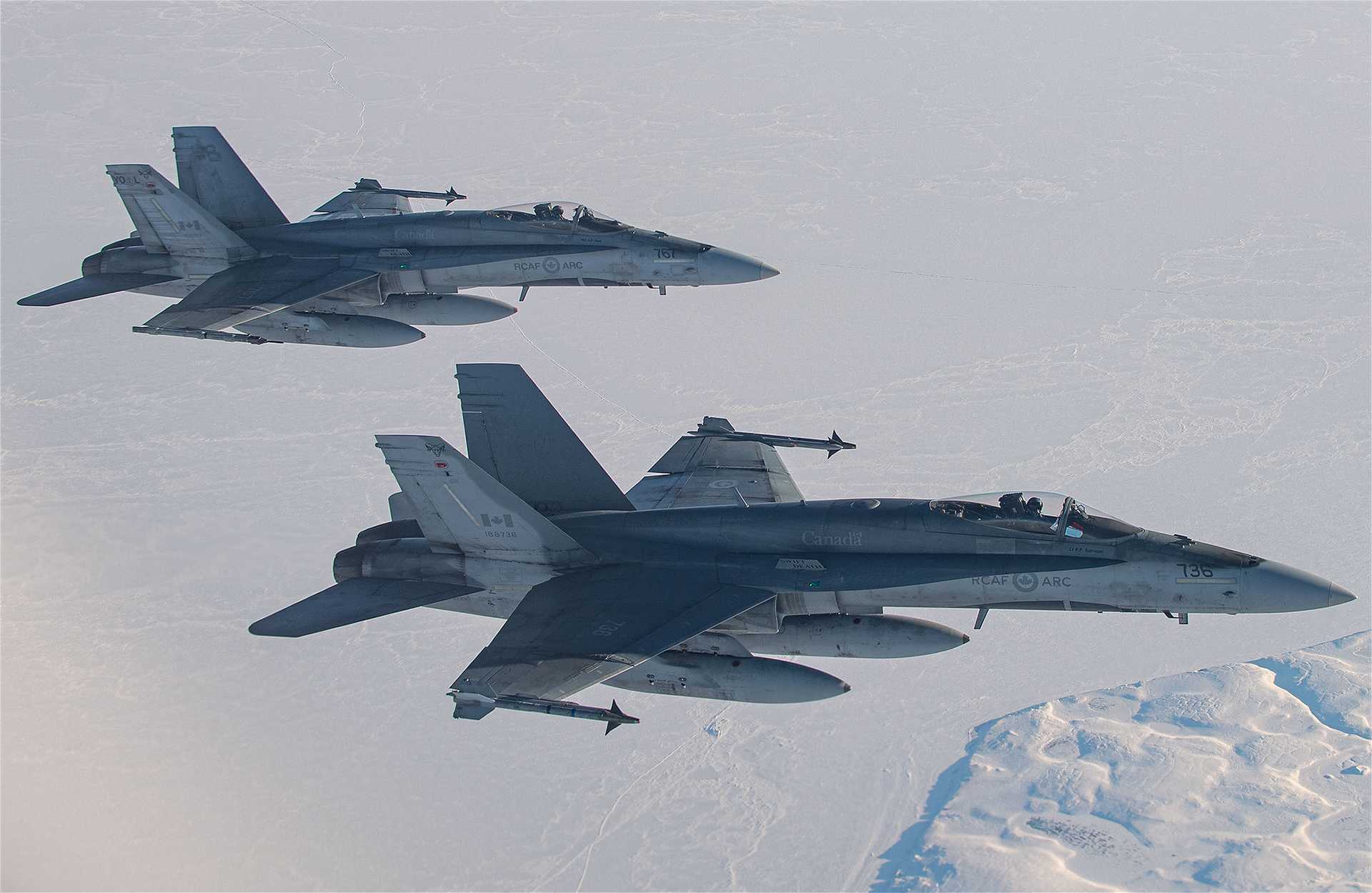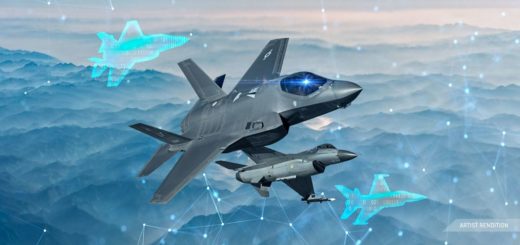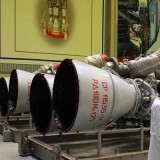Flash News: NORAD Deploys US and Canadian Jets to Monitor Russian Aircraft in Arctic Amid Growing Global Interest

{loadposition bannertop}
{loadposition sidebarpub}
According to a statement released by the North American Aerospace Defense Command (NORAD) on January 30, 2025, U.S. and Canadian fighter jets were deployed earlier this week to monitor multiple Russian military aircraft operating near the Arctic region. This swift response underscores NORAD’s heightened vigilance amid escalating strategic competition in the resource-rich and increasingly accessible Arctic region, as geopolitical tensions continue to rise. Follow Army Recognition on Google News at this link
Two Canadian CF-18 Hornets conducting a patrol operation over the Arctic as part of NORAD’s ongoing defense measures. (Picture source: Archive image Canada MoD)
According to NORAD (North American Aerospace Defense Command), the Russian aircraft remained within international airspace and did not enter the Air Defense Identification Zones (ADIZ) of either the United States or Canada, nor did they breach any sovereign borders. Despite the lack of immediate threat, the operation reflects ongoing concerns over growing military activity in the Arctic, where shifting ice patterns are opening up new trade routes and increasing competition for resources.
To monitor the situation, NORAD launched a multi-layered response. The Canadian NORAD Region (CANR) dispatched two CF-18 Hornet fighter jets, supported by a KC-135 refueling aircraft. From the Alaskan NORAD Region (ANR), NORAD launched two U.S. F-35 Lightning II stealth fighters, along with two KC-135 Stratotanker refueling aircraft and one E-3 Sentry AWACS (Airborne Warning and Control System) surveillance aircraft. The E-3 AWACS, a critical asset in both NATO and NORAD operations, provided real-time airspace monitoring, enhancing situational awareness during the operation.
NORAD highlighted that this monitoring operation was part of its routine defense measures, emphasizing the importance of its ability to detect, track, and positively identify aircraft. “Our ability to detect, track, and positively identify aircraft is critical to maintaining the security of North American airspace,” said a NORAD spokesperson.
The monitoring of Russian aircraft highlights the strategic importance of the Arctic to both Russia and North America. As the Arctic region’s ice continues to melt due to climate change, new shipping lanes and untapped natural resources are becoming increasingly accessible, making it a focal point of global competition. The region is believed to hold a significant portion of the world’s untapped oil and gas reserves, as well as mineral resources vital for future technological advancements, such as rare earth elements essential for electronics and green energy technologies.
For Russia, the Arctic is a critical area for both military and economic expansion. Over the past decade, Russia has been heavily investing in its Arctic military infrastructure, modernizing bases, deploying advanced weapons systems, and increasing the presence of its Northern Fleet. These activities are seen as a means to assert dominance in the region, control key shipping routes, and secure access to energy reserves. In particular, Russia has taken steps to strengthen its control over the Northern Sea Route (NSR), which provides a faster shipping lane between Europe and Asia as it navigates through Arctic waters, previously inaccessible due to thick ice cover.
For the United States and Canada, maintaining control and influence in the Arctic is crucial to national security and economic interests. The U.S. sees the Arctic as a potential gateway for military power projection, given its proximity to the Russian Federation. In addition, the U.S. is committed to ensuring the safe passage of commercial ships through Arctic waters and preventing any foreign military presence that could threaten vital trade routes or pose a strategic military advantage. For Canada, which shares the Arctic region with the U.S., maintaining sovereignty over its northern territories and airspace is paramount.
In response to Russia’s growing presence, both the U.S. and Canada have ramped up their military readiness in the region. NORAD, as the command responsible for defending North American airspace, plays a vital role in monitoring and responding to Russian activities, whether they involve air incursions or maritime threats. This week’s monitoring operation is just one example of NORAD’s broader mission to ensure that any potential military escalation in the Arctic is met with a rapid, coordinated defense response.
The presence of Russian military aircraft in the Arctic region has implications that extend beyond just regional security. It impacts global geopolitics, especially in the context of Russia’s broader military posture. The increasing frequency of Russian patrols and exercises in the region, including those involving advanced bomber aircraft and long-range surveillance platforms, signals Russia’s intent to assert its dominance over the Arctic, a region it views as integral to its national security and economic ambitions.
For the U.S. and Canada, the Arctic is not only important for the defense of their sovereignty but also for securing the flow of global commerce and access to energy resources. By monitoring Russian aircraft and demonstrating a strong defense presence, NORAD sends a clear message that North America will not allow the region to become a flashpoint for military conflict. Moreover, it underscores the strategic value of cooperation between the U.S. and Canada, as both nations continue to strengthen their defense capabilities in the High North.
In addition to military considerations, the Arctic’s growing accessibility could reshape global trade patterns, with countries seeking to control or influence new shipping lanes. The U.S. and Canada, both of which are major trading powers, cannot afford to lose control over these vital maritime routes. With China also eyeing the Arctic for trade and resource extraction, the competition for control over these emerging lanes will intensify in the coming years.
NORAD’s deployment of advanced fighter jets, AWACS surveillance, and tanker support is a clear indication that the defense of North America extends beyond just its southern borders. The Arctic, as the “High North” becomes an area of increasingly strategic importance. With tensions over Russian activities in the region likely to persist, NORAD’s readiness and response capability will remain a key component in ensuring North American security in the face of a rapidly changing geopolitical landscape.
While no further provocations were reported following the monitoring operation, the incident highlights the rising tensions in the Arctic and signals the continued importance of joint U.S.-Canadian defense efforts. As NATO allies bolster their defenses in the region, NORAD’s vigilance remains a cornerstone of North American security strategy, providing a deterrent to any potential threats emerging from the growing military and strategic competition in the Arctic. The ability to control and secure this crucial region will play a pivotal role in shaping the global balance of power in the years to come.

{loadposition bannertop}
{loadposition sidebarpub}
According to a statement released by the North American Aerospace Defense Command (NORAD) on January 30, 2025, U.S. and Canadian fighter jets were deployed earlier this week to monitor multiple Russian military aircraft operating near the Arctic region. This swift response underscores NORAD’s heightened vigilance amid escalating strategic competition in the resource-rich and increasingly accessible Arctic region, as geopolitical tensions continue to rise.
Follow Army Recognition on Google News at this link
Two Canadian CF-18 Hornets conducting a patrol operation over the Arctic as part of NORAD’s ongoing defense measures. (Picture source: Archive image Canada MoD)
According to NORAD (North American Aerospace Defense Command), the Russian aircraft remained within international airspace and did not enter the Air Defense Identification Zones (ADIZ) of either the United States or Canada, nor did they breach any sovereign borders. Despite the lack of immediate threat, the operation reflects ongoing concerns over growing military activity in the Arctic, where shifting ice patterns are opening up new trade routes and increasing competition for resources.
To monitor the situation, NORAD launched a multi-layered response. The Canadian NORAD Region (CANR) dispatched two CF-18 Hornet fighter jets, supported by a KC-135 refueling aircraft. From the Alaskan NORAD Region (ANR), NORAD launched two U.S. F-35 Lightning II stealth fighters, along with two KC-135 Stratotanker refueling aircraft and one E-3 Sentry AWACS (Airborne Warning and Control System) surveillance aircraft. The E-3 AWACS, a critical asset in both NATO and NORAD operations, provided real-time airspace monitoring, enhancing situational awareness during the operation.
NORAD highlighted that this monitoring operation was part of its routine defense measures, emphasizing the importance of its ability to detect, track, and positively identify aircraft. “Our ability to detect, track, and positively identify aircraft is critical to maintaining the security of North American airspace,” said a NORAD spokesperson.
The monitoring of Russian aircraft highlights the strategic importance of the Arctic to both Russia and North America. As the Arctic region’s ice continues to melt due to climate change, new shipping lanes and untapped natural resources are becoming increasingly accessible, making it a focal point of global competition. The region is believed to hold a significant portion of the world’s untapped oil and gas reserves, as well as mineral resources vital for future technological advancements, such as rare earth elements essential for electronics and green energy technologies.
For Russia, the Arctic is a critical area for both military and economic expansion. Over the past decade, Russia has been heavily investing in its Arctic military infrastructure, modernizing bases, deploying advanced weapons systems, and increasing the presence of its Northern Fleet. These activities are seen as a means to assert dominance in the region, control key shipping routes, and secure access to energy reserves. In particular, Russia has taken steps to strengthen its control over the Northern Sea Route (NSR), which provides a faster shipping lane between Europe and Asia as it navigates through Arctic waters, previously inaccessible due to thick ice cover.
For the United States and Canada, maintaining control and influence in the Arctic is crucial to national security and economic interests. The U.S. sees the Arctic as a potential gateway for military power projection, given its proximity to the Russian Federation. In addition, the U.S. is committed to ensuring the safe passage of commercial ships through Arctic waters and preventing any foreign military presence that could threaten vital trade routes or pose a strategic military advantage. For Canada, which shares the Arctic region with the U.S., maintaining sovereignty over its northern territories and airspace is paramount.
In response to Russia’s growing presence, both the U.S. and Canada have ramped up their military readiness in the region. NORAD, as the command responsible for defending North American airspace, plays a vital role in monitoring and responding to Russian activities, whether they involve air incursions or maritime threats. This week’s monitoring operation is just one example of NORAD’s broader mission to ensure that any potential military escalation in the Arctic is met with a rapid, coordinated defense response.
The presence of Russian military aircraft in the Arctic region has implications that extend beyond just regional security. It impacts global geopolitics, especially in the context of Russia’s broader military posture. The increasing frequency of Russian patrols and exercises in the region, including those involving advanced bomber aircraft and long-range surveillance platforms, signals Russia’s intent to assert its dominance over the Arctic, a region it views as integral to its national security and economic ambitions.
For the U.S. and Canada, the Arctic is not only important for the defense of their sovereignty but also for securing the flow of global commerce and access to energy resources. By monitoring Russian aircraft and demonstrating a strong defense presence, NORAD sends a clear message that North America will not allow the region to become a flashpoint for military conflict. Moreover, it underscores the strategic value of cooperation between the U.S. and Canada, as both nations continue to strengthen their defense capabilities in the High North.
In addition to military considerations, the Arctic’s growing accessibility could reshape global trade patterns, with countries seeking to control or influence new shipping lanes. The U.S. and Canada, both of which are major trading powers, cannot afford to lose control over these vital maritime routes. With China also eyeing the Arctic for trade and resource extraction, the competition for control over these emerging lanes will intensify in the coming years.
NORAD’s deployment of advanced fighter jets, AWACS surveillance, and tanker support is a clear indication that the defense of North America extends beyond just its southern borders. The Arctic, as the “High North” becomes an area of increasingly strategic importance. With tensions over Russian activities in the region likely to persist, NORAD’s readiness and response capability will remain a key component in ensuring North American security in the face of a rapidly changing geopolitical landscape.
While no further provocations were reported following the monitoring operation, the incident highlights the rising tensions in the Arctic and signals the continued importance of joint U.S.-Canadian defense efforts. As NATO allies bolster their defenses in the region, NORAD’s vigilance remains a cornerstone of North American security strategy, providing a deterrent to any potential threats emerging from the growing military and strategic competition in the Arctic. The ability to control and secure this crucial region will play a pivotal role in shaping the global balance of power in the years to come.





